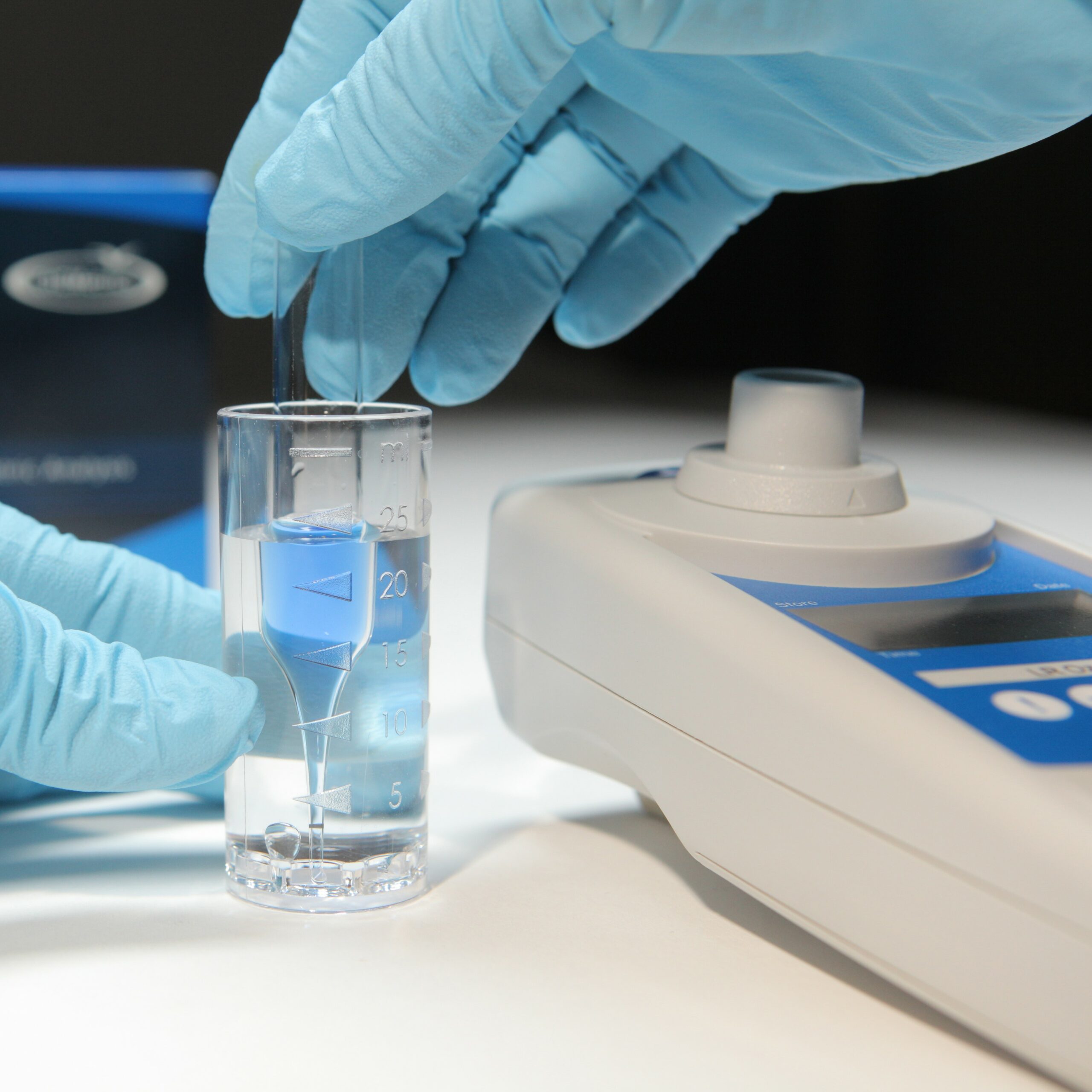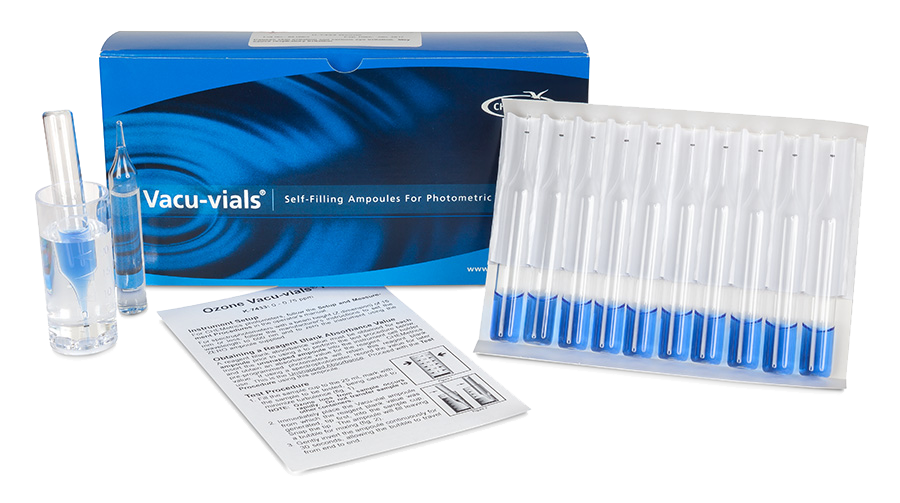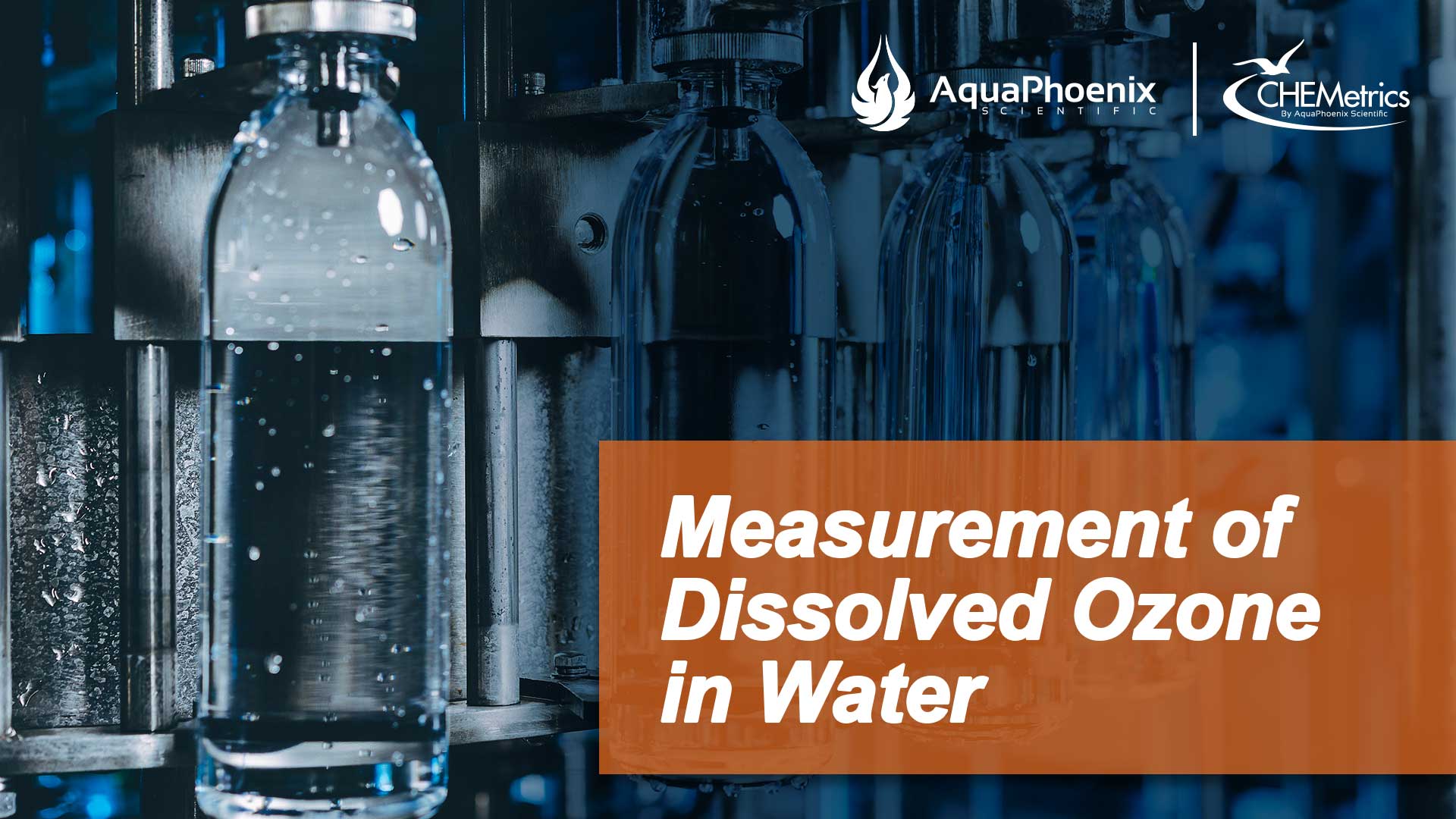Why Measure Ozone in Water?
Ozone (O3) treatment has become an important tool for water quality engineers. As new more stringent requirements from regulators and customers must be met, ozone is often the oxidizer and disinfectant of choice for a wide range of process applications. Ozonation is used for viral, bacterial, and parasitic disinfection, the removal of taste- and odor-causing compounds, the destruction of refractory/toxic organic matter and the coagulation or oxidation of inorganic impurities such as iron, manganese and sulfides1.
With the rising popularity of ozone in water treatment comes the need for a versatile analytical method for the routine measurement of dissolved ozone in a variety of solution matrices. The indigo trisulfonate method has become a favorite as it is accurate and precise over a wide concentration range, insensitive to interferences, and easy to use and dispose of. This method uses a non-toxic blue dye that is instantly decolorized by ozone. Interference from the most common oxidizer, chorine, can be masked with malonic acid (C3H4O4). The method is described in Standard Methods for the Examination of Water and Wastewater (Method 4500-O3 B)2 and is offered as a product in various forms by a number of companies.
More protective public health standards for drinking water have led to the expansion of ozonation for water treatment. For example, more stringent regulations have been implemented to reduce the concentration of harmful disinfection byproducts (DBPs), such as trihalomethanes (THMs) and haloacetic acids (HAAs), that are formed as a result of disinfection with chlorine and other halogens. Treatment with ozone does not produce DBPs and is therefore preferable. Ozonation is also an effective treatment option in circumstances where disinfection for more resistant pathogens, such as Cryptosporidium oocysts and some viruses, is required. In order for chlorine to be effective at disinfecting the more resistant pathogens, the concentration and/or contact time must be increased beyond what would otherwise be necessary. This tends to increase THM and HAA concentrations to levels that could be dangerous. Some utilities have installed ozone contactors to boost disinfection potential without increasing DBP production. However, conditions can limit the suitability of ozone for water treatment. When bromide ion (Br–) is present in the source water, its oxidation by ozone can result in the production of bromate (BrO3–), a DBP with an EPA drinking water limit of 10 ppb3.
Utilities that choose ozonation tend to have greater customer satisfaction due to improvements in other water quality parameters such as color, taste, odor, and clarity. Ozone also removes dissolved inorganic impurities such as iron, manganese and sulfide through coagulation and oxidation. Ozone can remove these impurities more efficiently than a conventional aerator, allowing reduced coagulant dosage and contact time. Advanced Oxidation, or ozone supplemented with hydrogen peroxide or UV radiation, may be required when oxidation of refractory or toxic organic matter, such as humic acids and pesticides, is required. These compounds are not degradable by chlorine, biological oxidation, or ozone alone. Combining ozone with hydrogen peroxide or UV radiation causes the ozone to degrade rapidly, resulting in a pulse of extremely reactive free radicals.

Industrial and Commercial Applications of Ozone
Food Industry
New avenues for the application of ozone in the food industry were opened in 1997 when the U.S. Food and Drug Administration granted “generally recognized as safe” (GRAS) status to ozone. Cleaning fruits and vegetables by washing with ozonated water decreases the concentration and volume of waste, the total water consumption, and contamination by mold and bacteria4. For meat, poultry and seafood, ozone can extend shelf-life and reduce processing costs. Generally, products are sprayed with ozonated water then kept in an ozonated atmosphere to further decrease spoilage.
Bottled Water
Ozone treatment is common in bottled water manufacturing. Although production methods vary depending on the size of the operation and quality of the source water, all methods for the U.S. market must produce a product that can pass the U.S. FDA regulations, which are required to be at least as protective of public health as those required by the EPA for public drinking water. Due to the use of filtration, reverse osmosis, activated carbon adsorption, and ozone treatment, there have been no major outbreaks of illness associated with bottled water in the past decade in the United States5.
In a bottled water plant, ozone is added to the water in the final operation just before bottles are filled. Generally, ozone gas is injected into a large tank of water until it reaches a desired concentration after which the water is transferred to the bottle. The ozone concentration must be high enough to kill any organisms, yet low enough that it does not attack the bottle or linger greet the consumer. This is about 0.4 ppm (mg/L) ozone.6 As with public drinking water, ozone may introduce the disinfectant byproduct bromate if the source water contains a significant amount of bromide.
Other Industries
Ozone is also applied as a disinfectant and oxidizer in these applications: aquaculture (nitrite oxidation), pools and spas, soil/groundwater remediation (underground storage tank contaminants), farming, winery sanitation (barrel/tank cleaning), electronics (surface cleaning), cooling water towers, laundry (deodorizing), indoor air pollution (particle removal), and industrial wastewater in general.
Ozone Analysis Using Sensors and UV Equipment
The techniques for measuring dissolved ozone can be divided into two methods: instrumental and colorimetric. The three main instrumental methods are: Oxidation/Reduction Potential (ORP), membrane probe, and UV absorbance. These methods all offer the advantage of giving continuous readings, and they avoid ozone degassing during sampling when used in-line. The instruments are generally calibrated using colorimetric methods, except for the UV absorbance method.
Oxidation/Reduction Potential
The ORP method measures the voltage generated by ozone in the solution at a platinum electrode relative to a standard reference electrode. It requires very clean water with at most moderate turbidity.
Classical Wet Chemistry Methods for Measuring Ozone
The three main wet chemistry methods for measuring ozone in water are: iodometric titration, N, N-diethyl-p-phenylenediamine (DPD) and indigo trisulfonate.
Iodometric Titration Method
In the iodometric method, ozone reacts with potassium iodide (KI) to form iodine (I2), which is then titrated with thiosulfate to a starch indicator endpoint with the sample buffered to pH 2. However, this method requires training and skill as the stoichiometry of the reaction is sensitive to pH, buffer composition and concentration, iodide ion concentration, sampling techniques, and reaction time7.
DPD Colorimetric Chemistry
In the DPD method, ozone reacts with potassium iodide (KI) to form iodine which then reacts with DPD to produce a pink compound. The intensity of the pink color is proportional to the ozone concentration and is measured at about 515 nm on a colorimeter or spectrophotometer. Iodometric and DPD methods have the disadvantage that they cannot discriminate between ozone and other common oxidizers. Several vendors manufacture colorimetric test kits that utilize DPD/KI in either powder or tablet form. However, the sample manipulation required to dissolve the tablet or powder can cause a loss in measured ozone concentration. This drawback is minimized by an ozone test kit with a liquid KI reagent that is added to the sample with a dropper bottle. This method, manufactured only by CHEMetrics, also uses a liquid DPD reagent packaged in a unit-dose glass ampoule sealed under vacuum. The reaction takes place inside the ampoule which increases the overall accuracy and precision of the method. The method is applicable to samples that do not contain chlorine.

Indigo Trisulfonate Colorimetric Chemistry
The indigo trisulfonate method has several advantages over the other two techniques. According to Standard Methods, “The indigo colorimetric method is quantitative, selective and simple. The method is applicable to lake water, river infiltrate, manganese-containing groundwaters, extremely hard groundwaters, and even biologically treated domestic wastewaters.” Indigo trisulfonate is usually sold as the potassium salt. The purity of indigo trisulfonate may vary between vendors and even between different lots from the same vendor. Both purity and age of the indigo trisulfonate have been shown to affect the stoichiometry of the reaction with ozone.8 High purity indigo trisulfonate (>80%) has a molar absorptivity of about 20000 M-1cm-1 at 600 nm.
The method is based on the decolorization of the indigo dye by ozone. The loss of color is directly proportional to the ozone concentration. The sample is generally adjusted to near pH 2 to minimize destruction of the ozone by reaction with hydroxide ions. The most common analytical procedure subtracts the absorbance of indigo trisulfonate after reaction with a sample from that of an ozone free blank. Chlorine decolorizes indigo trisulfonate at a moderate rate, but this can be significantly slowed by the addition of malonic acid.
Oxidation products from the reaction of the manganous ion (Mn+2) with ozone can destroy indigo trisulfonate. To measure ozone in the presence of manganous ion, glycine is added to a sample to selectively destroy the ozone, then indigo trisulfonate is added to measure the apparent ozone concentration due to the reaction with manganous ion oxidation products. This value is subtracted from the value obtained from a sample without glycine added.
Indigo Trisulfonate Test Kits
CHEMetrics is a major manufacturer of indigo trisulfonate test kits. The kits feature self-filling reagent ampoules that contain the active ingredients potassium indigo trisulfonate and malonic acid. The malonic acid in the reagent prevents interference from up to 10 ppm chlorine. The ampoules contain a liquid reagent, advantageously allowing the dissolved indigo trisulfonate to instantly react with the ozone in the sample as it is drawn into the ampoule.
CHEMetrics’ indigo ozone product measures an ozone concentration range of 0-0.75 ppm. The ampoules have a 13 mm diameter and are compatible with most spectrophotometers.

Since the ozone concentration is measured by the loss of indigo trisulfonate, both initial and final absorbance measurements are required. To accomplish this, the CHEMetrics product uses a “self-zeroing” method that measures the absorbance of the same ampoule before and after sampling, eliminating the need to generate an initial indigo trisulfonate absorbance ampoule each time a test is run. The initial absorbance measurement, before taking in the sample, is divided by a factor that takes into account the dilution once the ampoule has filled. The difference between the initial absorbance divided by the factor, and the absorbance after sampling, is converted to ozone concentration. A direct read photometer, called a Single Analyte Meter, is available that automatically makes all appropriate calculations.
References
- Rakness, K., (2005) Ozone in Drinking Water Treatment: Process Design, Operation, and Optimization.
- Standard Methods for the Examination of Water and Wastewater, 22nd ed. (2012) 4500-03 B, 4-145 .
- Haag, W. R., and J. Hoigne (1983) Ozonation of bromide-containing waters: kinetics of formation of hyprobromous acid and bromate. Environ. Sci. Technol. V17, p 261.
- Spartan Environmental Technologies, LLC, Tech. Bulletin TA-112064.
- Edberg, S., Microbial Health Risks of Regulated Drinking Waters in the United States: A Comparative Microbial Safety Assessment of Public Water Supplies and Bottled Drinking Water (2013) Drinking Water Research Foundation, 31 p.
- Bollyky, L. J., Benefits of Ozone Treatment for Bottled Water (2001) http://pacificozone.com/wp-content/uploads/2014/04/app_1388591099.pdf.
- Langlais, B., D.A. Reckhow, and D.R. Brink eds. (1991) Ozone in Water Treatment: Application and Engineering. Chelsea, Mich.: Lewis Publishers, Inc.
- Gordon, G., R. Gauw, Y. Miyahra, B. Walters, and B. Bubnis (2000) Using Indigo Absorbance to Calculate the Indigo Sensitivity Coefficient. Jour. AWWA, V92, pp. 96-100


